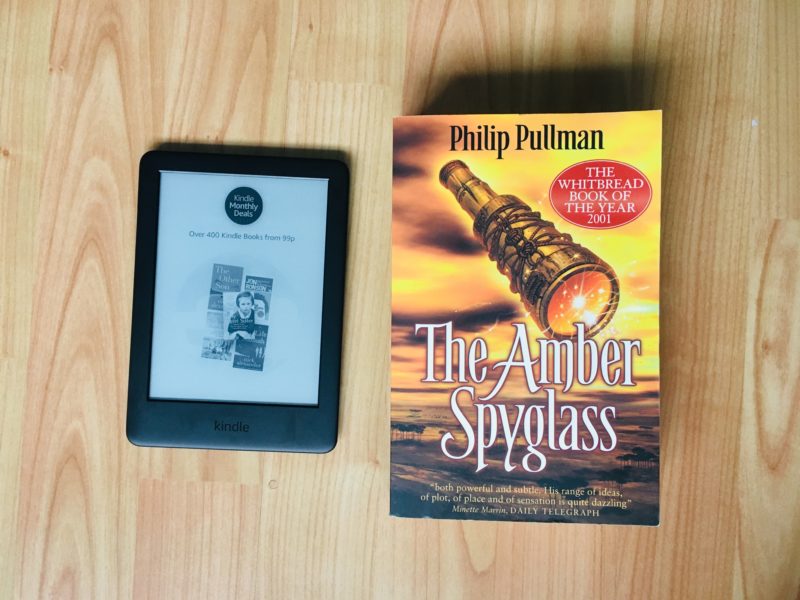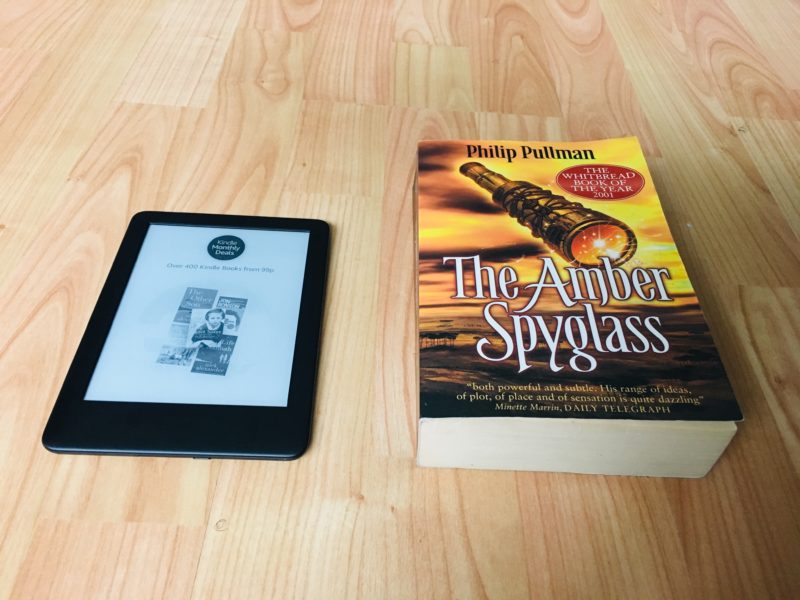Book vs kindle
Books are a centuries-old technology, can they be improved upon?

Last week I bought myself a Kindle, Amazon’s version of an e-reader. It’s the third Kindle I’ve had in a period of about 10 years and each one has had new features designed to improve the reading experience. But how does a Kindle compare to an actual book?
Size
When I was at university I remember reading Phillip Pullman’s, His Dark Materials trilogy on my commute. I had a 45 minute tube journey from my house into uni and I got a lot of reading done. Once I was nearing the end of The Subtle Knife (2nd book in the trilogy) and I was so into the story that I wanted to start the next book, The Amber Spy Glass, straight away. I carried both books in my bag just to make sure I wouldn’t miss a single second of precious reading time. The Amber Spy Glass is a chunky book. It took up a lot of space in my rucksack. This is where the Kindle really comes into its own. 100 page novella? 500 page beast? No matter, they all take up hardly any space on a Kindle.

Battery life
Books don’t generally have a battery, so I guess they have the edge here. Kindle battery life is several weeks, but it does diminish with age which is why I’ve had to purchase a new one (my previous one is 7 years old). So many daily devices need cables and some way to charge them up that it’s refreshing to use an item that will keep doing what it is meant to without having to worry that it will switch itself off leaving you stranded mid-s
Loosing your place
I share a house with three youngish children. They are curious, which is wonderful, but they don’t reserve that curiosity for items that belong to them. Phones get picked up for random selfies, clothes get tried on and books get moved to become ramps, motorways or bridges. Moved books often mean that bookmarks get dropped and places get lost. It’s hard to lose your place in a story when you are using a Kindle. In fact, you can keep your place on different devices and have it sync with your audio version of the book too (as long as you keep it in the Amazon family on Audible, of course).
Navigation and highlighting
I’m going to tell you something that you mustn’t tell my mum. I write in books. Underline words, write in margins, boxes around key phrases (apparently it called marginalia). My mum would consider this sacrilege, so make sure you don’t mention it. I find it a useful way to engage with the text and let ideas sink in, especially for non-fiction. On the Kindle there is a highlight function and you can make notes but I’ve found it clunky on each of three different versions of the Kindle I’ve had. My current is a touch screen so it’s probably the easiest but I still find it way simpler using a pen or pencil in a physical book.

For any book I think I’ll want to use for reference later I prefer a physical book. I find it much easier to jump around and skim in physical books and I still find real life post-it notes better than electronic book marks for easily returning back to key info. There’s probably a cool search function or something I can use to find relevant passages but my “can’t be arsed” thresholds can be low and it only works if you remember the words you want rather than roughly how far through a book something was as I do.
Which brings me to…
Pages over %
I hate seeing the % read (default for Kindle) rather than the page I’m on. It’s irrational but we all have flaws.
Reading in bed
Are you even a real book lover if you haven’t hidden under the covers trying to read a book before bed? Either because your parents would moan at you to go to bed or whoever you share your room or bed with can’t sleep with a light on. Physical books have two flaws here. Firstly, you need a light that will fit under the covers. Secondly, the restricted space generally means you have to read using one hand which can be more difficult than you first think, especially for thick books and when it comes to turning pages. Kindle emerges victorious here. Backlit and very comfortable into one of my (fairly small) hands. Turning an electronic page has evolved over serval models from click of a button to swipe of a screen. Undercover reading is a breeze.
Reading experience
A well designed book is a beautiful thing. Cover design, feel, thickness of pages. Smell. Reading a book can be a sensory experience well beyond just using your sight. This experience is lost on Kindle.
Some books are designed to be experienced as wonderful items in their own right. When G was little he had a copy of Lost and Found. A beautiful pop-up book that fell apart after years of use and delight. I have a number of photography books where the weight of the paper and colours of the print have been carefully considered. These are seriously diminished on Kindle (and any screens to be honest). When I had input into the design of my own book I was heavily influenced by a magazine called Cereal, especially for the interior design. The details are small but I have had a number of readers specifically mention how the inside looked and felt. Interior book design changes on Kindle because the reader is able to choose the font size which is great for accessibility but terrible for geeky creators.
Accessibility
We always gently tease my mum because she has the texts on her phone at font size 1000 so she can read them. Books aimed at adults generally have fairly small font which can make it hard for anybody without perfect eyesight to read. The ability to change font size is a great feature for accessibility.
Cost and ease of buying
For many books the Kindle version is cheaper than a new physical copy and, because capitalism never sleeps, Kindle versions are instantly available rather than having to go to a shop or wait for delivery.
Which is the best?
Like many things it depends on the purpose. For some purposes Kindle has better functionality than physical books. But for overall beauty and ease traditional books are better. The oldest known printed text originated in China during the Tang Dynasty around 877 AD. Physical printed books are an extremely robust and resilient technology. I predict that they will outlast the Kindle by many generations but that won’t stop me using my Kindle to save space in my bag now.
……………………….
Enjoyed reading this blog post? Subscribe for future ones you’ll also get a free copy of my ‘9 lessons for unexpected leaders’ pdf.
If you are interested in the human side of leadership then my book The Unexpected Leader is for you.

